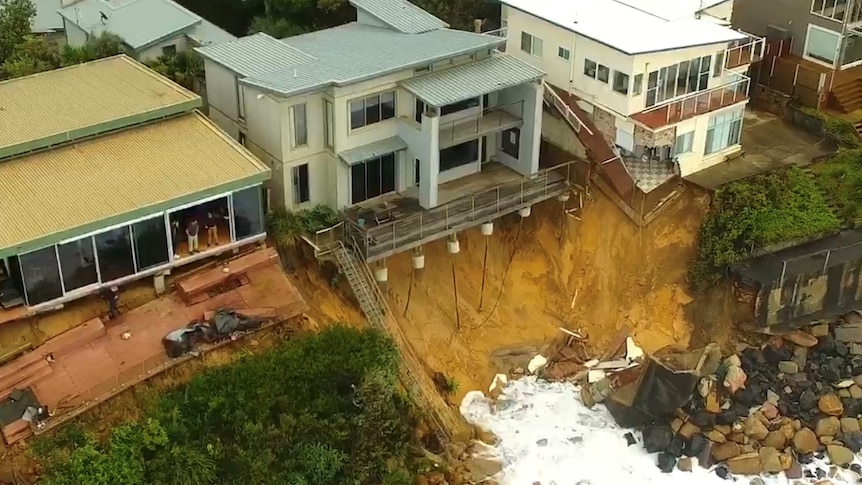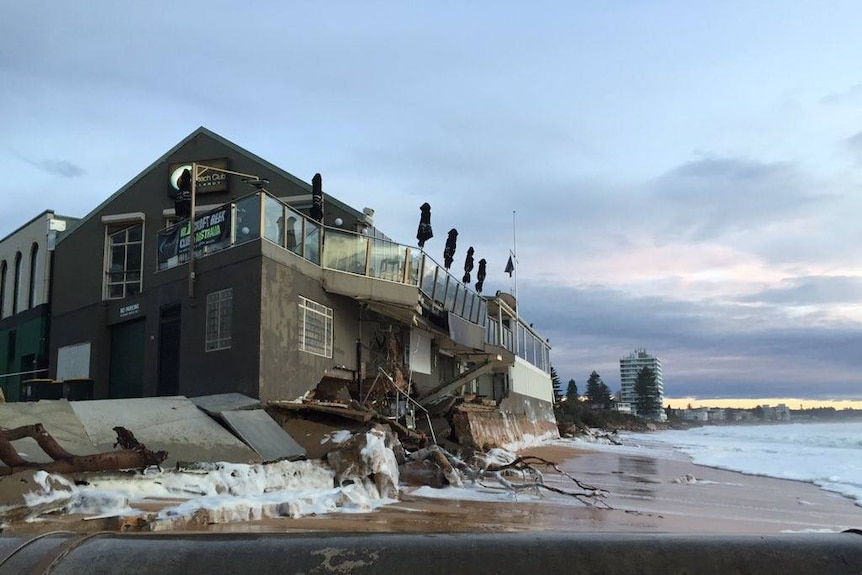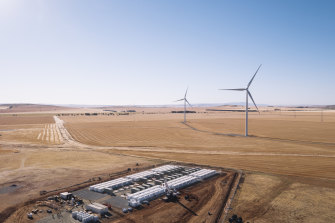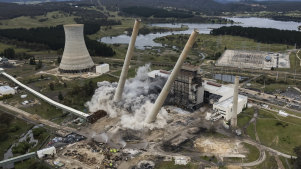ABC News
- Maani Truu

|
Sea level rise of close to a metre has been predicted by the end of
the century. (ABC News)
|
When Chris Rogers returned to the NSW Central Coast after a stint living
overseas, he was eager to embrace the quintessential Australian lifestyle —
a home where his kids could swim in the ocean whenever they liked and he
could walk along the beach he loves every day.
But more than a year after powerful swells battered Wamberal
Beach, causing massive erosion beneath the waterfront properties, he's been
left fearing his home could be washed away in the next storm surge.
"We've worked our whole life, this is our family home, and to look at your
kids and not be able to comfort them is scary," Rogers says.
"It's no different to someone sitting in a bushfire zone with a beautiful
home. They love the bush and they love living there, and … the fire burns
their home down. All we want to do is be able to protect our homes and our
families."
A year ago a massive storm caused severe coastal erosion at Wamberal
Beach. (ABC Central Coast: Sofie Wainwright)
Rogers, 47, feels lucky compared with his neighbours: some were forced to
evacuate when their homes partially collapsed in the storm. The home where
Rogers has lived with his wife and two children since 2016 remains intact, but
his backyard has "sunk" where sand from the beach was washed away.
"Every time there's heavy rain, everyone is having more and more of their bank
starting to collapse," he says. "If there are ... multiple east coast lows
that hit this beach at the right tide, you could have as many as 10 homes
going."
Rogers was attracted to the area by the relaxed pace of coastal living. Thanks
to a rise in remote working as a result of the pandemic, more people than ever
are making a similar decision to leave large cities and work from regional
locations.
But this pilgrimage is taking place against a backdrop of climate change, and
many of its impacts are already being felt — not just in Wamberal, but all along
Australia's coast.
Sea-level rise a reality
The latest report from the Intergovernmental Panel on Climate Change (IPCC)
— the most
comprehensive report on climate change
ever released — estimates a sea level rise of up to 55 centimetres by
the end of the century, while not ruling out a 2-metre increase in the same
period.
This would have catastrophic consequences for hundreds of thousands of
Australians living along coastlines and waterways.
In 2009, more than
a decade before the IPCC report, the federal government's now-dissolved
Department of Climate Change published a report measuring the risk to
Australia's coastline — the first and only time it did so for the entire nation.
The report identified between 157,000 and 247,600 individual
residential buildings at risk of inundation if sea levels were to rise by 1.1
metres. The replacement value for these houses, they estimated, was up to $63
billion.
Rogers, who has been leading a residents group agitating for a wall to be
built to
protect the coastline from further erosion, sees his home, and those of his neighbours, as the "first line of
defence" against rising sea levels.
"We're working really hard to try and work with the council or the government to
come up with potential solutions that protect not only us but all the
infrastructure behind us," he says. "Obviously I want to protect the home, but I
also want to protect the beach."
He hopes any protective action taken in Wamberal — "if we can do things right" —
could act as a blueprint for other coastal towns feeling the impacts of climate
change. "It's not just us," he says. "The exposure is massive, really massive,
and concerns are simply growing."
How big is the problem?
Australia is a nation built on the ocean, literally and figuratively. More than
80 per cent of the population already lives within 50 kilometres of a coastline
and the idealised beach lifestyle occupies a prime position in Australia's
national psyche.
And with the rapid rise of remote working, forced by health measures introduced
during the pandemic, executive director of the Australian Coastal Council's
Association Alan Stokes predicts the number of people seeking a slower pace and
water views is only set to grow.

|
Collaroy Beach Club on Sydney's northern
beaches was damaged by a high tide and low-pressure
system in 2016.(ABC News: Amanda Hoh)
|
"We're going to notice a big difference in the findings of the 2021 census," he
says. "I think we'll find that population levels in coastal areas — particularly
those within, or a little beyond, commuter distance from the capital cities —
are going to see enormous growth."
This is despite "at least a metre [of sea-level rise], probably
more" already locked in, according to David Wainwright, a coastal engineer of
almost 25 years. "The thing is the timing: if it's going to affect your property
in 100 years, is that something you worry about now?"
The impacts of sea-level rise will not be limited to beachfront homes, but
also properties in low-lying areas around estuaries or lakes. They are at
risk of what's called coastal inundation. "As the mean sea level rise goes up in
the ocean, you're also going to have the water level going up inside the estuary
by a similar amount," Dr Wainwright says.
It's this latter group that will experience more damage in the coming
decades. "This is a creeping issue that over time is going to inundate more and
more frequently — and for certain properties, it might get to the stage where
your property might be inundated by tides several times a year, even more. How
are we going to manage that?"
Stokes believes the gradual creep of climate change has lured home buyers into a
false sense of security.
"There's this perception that the worst of
it will be felt in 2100, so someone buying a house now in an area that's likely
to be impacted by 2100 is saying to themselves 'well, you know, that's so far in
the future it probably won't affect me now'," he says.
"But there will be increasing impacts during the period leading up to that."
If home-buyers aren't worried, the nation's financial institutions certainly
are.
In September, the Reserve Bank of Australia released a
report warning property values in climate change hot spots could soon take a
hit, leaving banks vulnerable in the case of default.
It warned that about 3.5 per cent of dwellings in Australia already fell under
the international definition of "high-risk", but that long-term climate
change risk wasn't being reflected in property values. South-east Queensland and
northern New South Wales had the largest number of homes at risk of coastal
inundation, the report found.
"If current values do not fully reflect the longer-term risks of climate change,
housing prices could decline, leaving banks with less protection than expected
against borrower default," it said.
What it means for property buyers
When it comes to the impact of climate change on the property market, Claire
Ibrahim, a director at Deloitte Access Economics, says the Reserve Bank is right
to expect material declines in housing prices over time in high-risk
regions.
But, she adds, this is largely separate from how buyers will value property in
the short term.
"Because people don't have the information at the moment that clearly tells them
with a level of certainty how it will change potentially for the negative
because of climate, I think they do assume that it will hold to an extent," she
says.
"You have homes that reflect exactly the value of what people are willing to pay
for them, but is it the right risk equation within that? No, it's probably not.
"But would you call it overvalued? No, not necessarily. Because you
could, in theory, sell it tomorrow and still make money from it."
But eventually, as banks increasingly start to factor climate risk in, high
insurance premiums will force buyers to reconsider the value of a property.
"It really does alter the equation of how we value living by the
water," Ibrahim says. "And it starts to change the assumption that probably
holds true for now that these properties will always maintain or increase their
value."
When will that tipping point come? Climate analyst Karl Mallon has set
about trying to answer that question. His company, Climate Valuation, seeks to
provide data on the actual risk of climate change to property buyers and the
banks that lend to them.
Up until now, he says, damage from sea level increase has been relatively rare.
That's because most buildings have been constructed above the current sea level
and set back from the coastline, forming what he describes as a "buffer".
He believes the impact of sea level rise will be mild for the next two or three
decades, after which coastal inundation will steadily worsen. "Coastal
inundation will be one of the worst impacts [from climate change] we're facing
in Australia," he says.
Should we reconsider coastal living?
According to the experts, this comes down to timing and whether the long-term
risk is worth the short-term benefits of living by the water.
"Time really matters," Ibrahim says. "When [people] make decisions, it
can be really difficult to factor in time and risk in a way that's meaningful
for how you value things."
While the impacts are already being felt in some areas, such as Wamberal, it is
harder to quantify in regions where the danger is less obvious.
By Climate Valuation's measure, about one in 20 properties are at high risk
of flooding and coastal inundation. Dr Mallon predicts this could increase
to one in 10 properties over the course of the century.
Without major works to protect them, these properties face the possibility
of becoming uninsurable. "You're going to have people sitting on a house which
they can't defend, they can't insure, and they can't sell," he says.
Governments across the world have embarked on large-scale engineering works
to stop water encroaching on properties, but Dr Mallon believes Australian
governments are less likely to go down that route because many at-risk areas
have small populations relative to the high cost of intervening.
"In the end, there will be suburbs that will be untenable in this
century," he says. "It's likely state governments and councils will just
give up."
Meanwhile, Dr Mallon recommends prospective home buyers research whether
a property is in an at-risk area, and if it is, make sure their insurance
policy covers flooding and inundation — often described as "actions of the sea".
But after a quarter of a century surveying Australia's coastlines, Dr Wainwright
argues we must shift our thinking. "A lot of it has to do with this
assumption that property is permanent," Dr Wainwright says. "When
you're talking about the coastline, that's not the case."
Links





